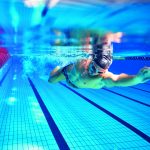My TOP 10 tips for surviving your first triathlon!
I certainly cannot describe myself as an expert triathlete, but my love of the sport and my background as a swimming trainer have allowed me to draw up a list of 10 tips I think might be useful when tackling your first Ironman or your first triathlon race.
Before we start, I would like you to keep in mind some important advice: never try anything new in a race! Everything must be rehearsed and tested out in training. In these sports improvisation = guaranteed failure!
So let’s get straight to the point. Here are my TOP 10 tips for successfully completing a race:
1. Study the course map carefully during the week leading up to the race and note down any important information. Study the swimming, cycling and running legs. Take note of where food & drink stations are located and what they offer to eat and drink. Attend the pre-race briefing session and ask athletes who have already taken part in the race for any tips they might have.
2. Keep a close eye on the weather: it is vitally important to have the right clothing during the race.
Make a list of the equipment you will need on the day, so that you do not forget anything. The day before the race, I suggest you divide your clothing into three separate groups for each of the different disciplines and then put them into three different bags (usually provided by the club organising the event), including any food/supplements you need to finish the race.
3. Visualise the race in your head. I have always found it extremely useful to create both a mental and physical plan for dealing with the most euphoric and toughest moments of the race. Always expect the unexpected and be ready for anything.
4. Set two alarms for the morning of the race and follow your usual routine. Breathe deeply and think positively. Keep telling yourself that THIS IS YOUR DAY and you have done everything to ensure it goes smoothly.
5. When you are positioning your bike in the transition area, memorise markers that will help you find it as quickly as possible when you come out of the water. Inflate your tyres and put your drinks bottles, gels and energy bars in the right places. Make sure your helmet is in the proper position, the lenses of your swimming goggles and cycling glasses are clean, and your number belt is ready to be put on.
6. Warm up for 15-20 minutes before the start of the swim and make room for yourself among all the other competitors 5 minutes before the start, this will help give you a real advantage.
If you are a fast swimmer, try and set off at the front of the race and be ready for an initial 200-400 m sprint. If, on the other hand, swimming is not your strong point, do not try and get to the front of the race: stay in the pack and be careful to avoid any accidental bumps and bangs. In this case, try and keep in the slipstream of the other competitors.
7. During the first transition (T1), take off your swimming goggles and cap. Once you have got to your bike, sit down and take off your swimsuit. Do not panic if you cannot get it off: take a deep breath, relax and try again. Once you have removed your swimsuit, put on your cycling glasses, then your helmet and slip on your number belt so that it can be seen from behind. You are now ready to begin the cycling leg.
8. Cycle the way you have trained. Monitor your heart rate and race at your own pace. Change your position in the saddle as the terrain varies. This will help you use different muscles, so you do not tire so quickly.
9. Increase your speed over the last kilometre leading into T2 and unclip your shoes when you are 100 m from the transition line. Get off your bike and run to your bike station. Put on your running socks and shoes, turn your number around to the front, take a deep breath and… off you run!
10. Learn to ignore the “pains” in your legs during the run, try to keep your stride short and efficient. Keep on talking to yourself. Relax your shoulders, neck, head and arms. Enjoy every moment and do not forget: this is your day!
I hope these tips have been useful. If, on the other hand, you already know all this, then it will at least have helped jog your memory.
Good luck, you’ll soon be an Ironman (or a Triathlete!).
Written by:
arena coaches
Swim coaches, trainers and experts will give you all kinds of tips for performing at your best in both training and races.







